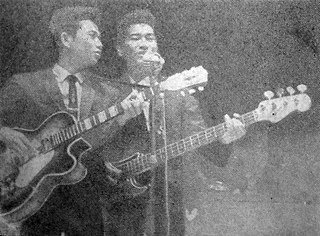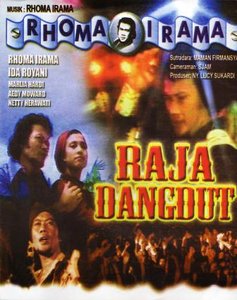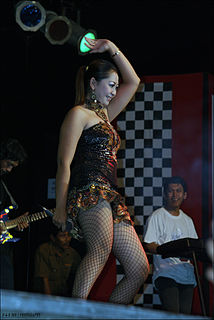
Dangdut is a genre of Indonesian folk music that is partly derived and fused from Hindustani, Arabic and to lesser extent, Malay and local folk music. Dangdut is a most popular musical genre in Indonesia and a very popular in other Malay world countries as well because of its melodious instrumentation and vocals. Dangdut features a tabla and gendang beat.

Inul Daratista is a dangdut singer and performance artist from Pasuruan, East Java, Indonesia. She became nationally famous in 2003, and is known for her suggestive style of dancing that caused major controversy in Indonesia. Inul is a corrupted version of Ainur, and the singer's childhood pet name. As she began her musical career singing in a 'rock' band, she adopted the stage name Daratista.

Raden Haji Oma Irama, better known as Rhoma Irama, is an Indonesian dangdut singer, songwriter and guitarist of Sundanese descent.
Elvy Sukaesih is one of the most popular dangdut singers in Indonesia, and has been dubbed the Queen of Dangdut. Sukaesih has a significant fan base in other Asian countries such as Japan. She has been a prolific recording artist since the late 1960s.

Colotomy is an Indonesian description of the rhythmic and metric patterns of gamelan music. It refers to the use of specific instruments to mark off nested time intervals, or the process of dividing rhythmic time into such nested cycles. In the gamelan, this is usually done by gongs of various size: the kempyang, ketuk, kempul, kenong, gong suwukan, and gong ageng. The fast-playing instruments, kempyang and ketuk, keep a regular beat. The larger gongs group together these hits into larger groupings, playing once per each grouping. The largest gong, the gong ageng, represents the largest time cycle and generally indicates that that section will be repeated, or the piece will move on to a new section.
Irama is the term used for tempo in Indonesian gamelan in Java and Bali. It can be used with elaborating instruments. It is a concept used in Javanese gamelan music, describing melodic tempo and relationships in density between the balungan, elaborating instruments, and gong structure. It is distinct from tempo, as each Irama can be played in different tempi. Irama thus combines "the rate of temporal flow and temporal density"; and the temporal density is the primary factor.

Senen is a long-established urban district of Jakarta, Indonesia that has kept many tourist attractions such as two museums, the National Library of Indonesia and Gelanggang Remaja Senen, a quite narrow alley with old Chinese and similar style shops and restaurants. It was first developed in the 18th-century as Pasar Senen when governor Daendels established the bovenstad as the new center of government of the fledgling city. Its kernel remains in what is now the formal lower-tier Village/Neighbourhood of Senen, within, the others being Kwitang, Kenari, Paseban, Kramat, and Bungur. This article covers the archetypal core and the whole Subdistrict of Central Jakarta.
Octavia Yati is an Indonesian actress. She mainly plays in dramas and romantic films.

Soekarno M. Noor was an Indonesian actor and film producer. He acted in 118 films and dramas.

Koes Plus, formerly Koes Bersaudara, is an Indonesian musical group that enjoyed success in the 1960s and 1970s. Known as one of Indonesia's classic musical acts, the band peaked in popularity in the days far before the advent of private television companies, delivering stripped-down pop and rock songs at the then-only TV station, TVRI.

Benyamin Sueb was an Indonesian comedian, actor and singer. He released 46 studio albums and starred in more than 50 films. He received two Citra Awards for Intan Berduri in 1973 and Si Doel Anak Modern in 1975.

Raja Dangdut is a film directed by Maman Firmansyah.

Begadang is an Indonesian film released in 1978 and directed by Maman Firmansyah. This film stars, among others, Rhoma Irama, Yati Octavia, and Billy Argo.
Lalsalu is a 2001 Bangladeshi film directed and produced by Tanvir Mokammel. The screenplay is based on Syed Waliullah's 1948 novel of the same name.

Netty Herawaty was an Indonesian actress who made more than fifty films between 1949 and 1986.

Darussalam was an Indonesian actor who appeared in more than seventy films in his forty-year career. Born in Bengkulu, he studied to be nurse before migrating to theatre during the Japanese occupation of the Dutch East Indies, marrying Netty Herawaty while with the troupe Irama Masa. The couple spent the remainder of the occupation and the ensuing revolution touring the archipelago with a number of troupes. In 1949, Darussalam and Herawaty made their feature film debut in Fred Young's Saputangan, appearing in seven further Young productions before migrating to Djamaluddin Malik's Persari. During their eight years with the company, Darussalam and Herawaty travelled to the Philippines and Singapore and found popularity among audiences, though Darussalam remained in his wife's shadow.

Husein Aidid was an Indonesian songwriter, singer and entrepreneur. Aidid was the founder and leader of the Orkes Gambus al-Usysyaaq which later became transformed into the Orkes Melayu Kenangan in 1950. Together with his new Malay Orchestra, on October 26, 1950, Aidid began its first broadcast on Radio Republik Indonesia and was broadcast nationally. At that time, RRI was the most popular entertainment facilities of society.

Syech bin Abdullah Albar or better known as Syech Albar was an Indonesian gambus singer of Hadhrami Arab descendants from Surabaya. Albar was pioneer of gambus music in Indonesia, he has a gambus orchestra named Al Wathon which first aired in 1935 at NIROM Surabaya. In Surabaya, Albar produced many gramophone plate recordings. His gramophone plate recording in 1937 was titled "Zahrotoel Hoesoen", with a description of "modern Arabic songs" and recorded on His Master's Voice (HMV) label. Albar signed a contract with HMV for the first time in 1931. In addition to HMV, the songs of S. Albar Orchestra were also recorded on the Canary Records label.

Soleram or Suliram is a folk song from Riau, Indonesia. It is also a well-known folk song in Malaysia. This song is melodious and sung in a gentle rhythm, with lyrics that are relatively short and easy to remember.

Koplo or dangdut koplo is a subgenre of dangdut, Indonesian popular dance & folk music, that originated in East Java during the early 2000s. The genre gets its name from the slang term "koplo" which refers to a hallucinogenic drug that is sold cheaply in Indonesia. Dangdut koplo is played at a faster tempo than the standard dangdut music and said to make listeners "feel high" thus gives the same effect of consuming koplo pills. Koplo also differs musically from the regular dangdut in the dominant role of the drummer, which plays more complex drum patterns.
















